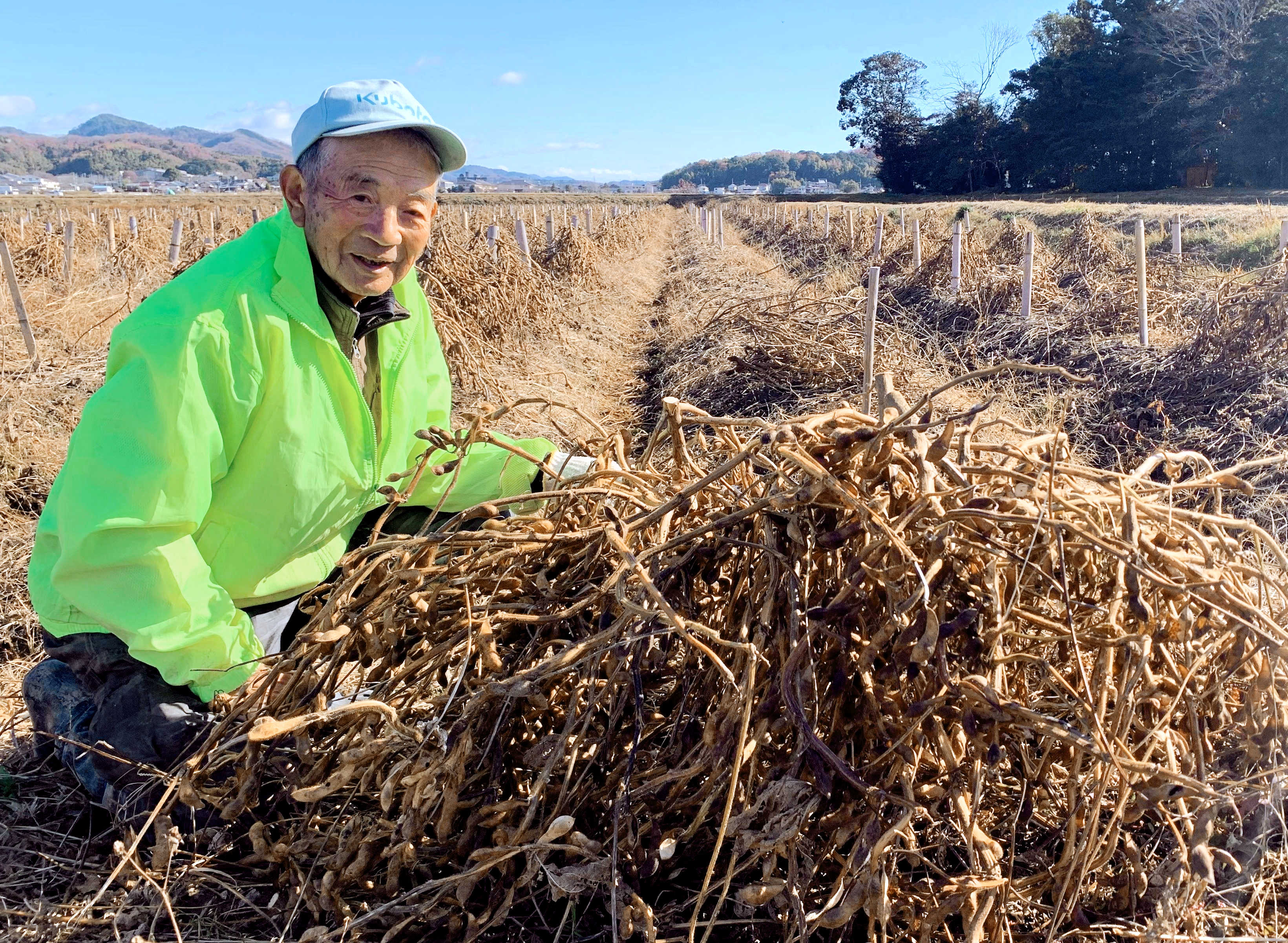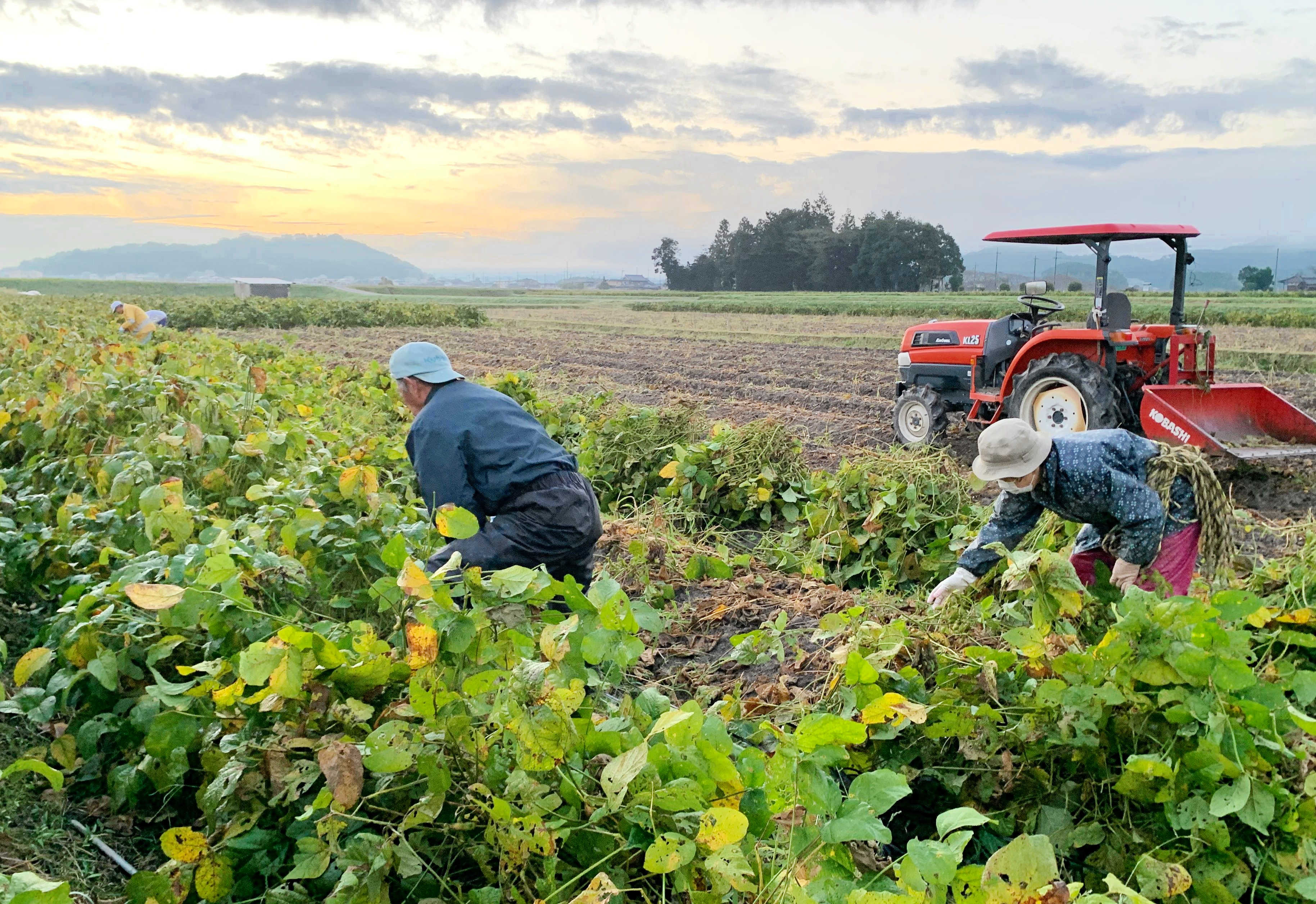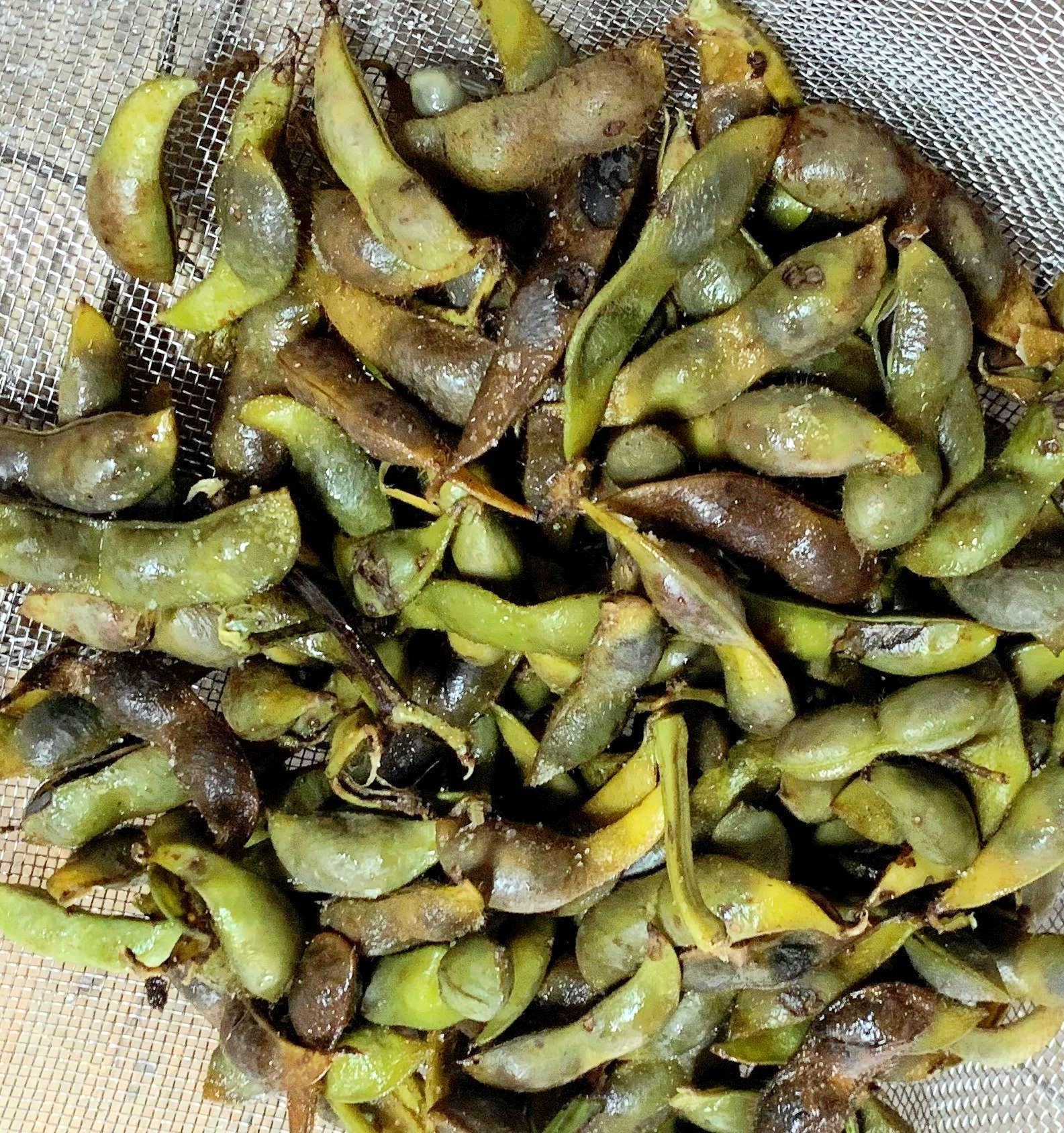Tamba black soybeans – superior amongst both black bean and edamame bean varieties
The unique richness and deep flavour of these black beans is certainly exquisite and may make you long for a beer. We had received some large Tamba black soybean edamame from autumn’s harvest. For storing and serving, the edamame beans are boiled lightly, then frozen quickly for storage, and then boiled again with salt to eat. “By doing this you can enjoy the fresh flavour for a whole year” Hirokazu Yamamoto (Kawagita, Tamba-Sasayama City), local specialty product meister of Tamba black soybeans, smiled as he explained.

Meister Hirokazu Yamamoto harvesting Tamba black soybeans (Kawagita, Tamba-Sasayama City)
The foundation of terroir is the soil. Starting with that topic, Mr. Yamamoto began recounting the long history of the Sasayama Basin, which stretches expansively from east to west.
Fossils and fertile soil
.jpg)
“In the past, this area used to be a lake, but due to tectonic movements, the Sasayama River began to flow into the Kako River, resulting in the discovery of dinosaur fossils in Kawashiro, a little west of here. Some other fossils were also found when digging was carried out on rice fields in Sasayama too”.
Unexpected fossil finds certainly is exciting. Especially considering that Kawashiro Valley is famous for being home to the Tamba dragons, while the find in Sasayama's rice fields is lesser known. Later, Shigehiro Kato, chief researcher at the Museum of Nature and Human Activities and an expert on geological formations explained that ‘it’s not surprising they were discovered here.” According to Kato, the Sasayama Basin was once the source of the Muko River in the south, but 30,000 years ago the passage flow was obstructed by earth and sand, resulting in the creation of Lake Sasayama. Eventually, water overflowed from the lake and into the Kawashiro Valley, eroding a path in the mountain surface and creating the present Sasayama River which flows into the Kako River.
The ‘Sasayama Group’, which stretches 18 kilometres from east to west from the Sasayama Basin to the eastern part of Sannan-cho, Tamba City, is a geological formation that is attracting attention for its dinosaur and ancient mammal fossils. With the creation of a new river 30,000 years ago began the carving out of geological strata from 100 million years ago, and some of the world's most valuable fossils have been discovered here. At the same time, the Sasayama Basin, which is covered with fertile black soil that was exposed when the lake water receded is also a gift from nature to the local area.
Acreage reduction policy saves the day

The edamame harvest in October beginning at sunrise.4
Tamba black soybean is a general term for native varieties cultivated in the former Tamba province. A description of black soybeans from Tamba appears in the cooking guidebook ‘Ryouri koumoku choumishou’ dating back to 1730 (mid Edo period). Currently, Tamba black soybean is cultivated on an area of 755 hectares (as per 2020) in Tamba-Sasayama City alone. This makes the story of how it grew into a special branded product all the more interesting. Hideki Morimoto, Tamba-Sasayama City Agricultural and Urban Creation Policy Officer, explained how their story really began when “farmers stopped growing rice in some of their fields and used it as farmland instead due to water shortages.” From early on farmers incorporated block rotation (as they do not grow well on repeatedly used farmland) and other growing techniques such as using large ridges, which are unique to Tamba black soybeans.
There are two indigenous strains of Tamba black soybeans: the Kawagita black soybean, which has been passed down in the aforementioned Kawagita district by Mr. Yamamoto mentioned above, and the Habe black soybean, which is grown in the Hioki district. They gained popularity in the Edo period (1603-1868), and were relished by wealthy people in Tokyo, Osaka, and Kyoto even after the Meiji period (1868-1912). However, after WW2 the cultivation land area decreased, and by around 1960 only 10 hectares remained. “It was actually the rice surplus that saved Tamba black soybeans from extinction. Due to the surplus, the acreage reduction policy was introduced in 1971 to encourage people to switch to other crops” explained Morimoto.
Efforts to grow the size of the bean also advanced. In order to stand out from black soybeans produced in Hokkaido, Tamba’s farmers and agricultural cooperatives repeatedly selectively grew large beans, and by the 2000s they had achieved beans double the size of what they were in the 1940s. As Tamba black soybean's popularity and price increased, cultivation spread to other prefectures such as Okayama, Shiga, and Kagawa, as well as present-day Shiso City, Asago City, and Taka Town, which share the same inland climate as Sasayama. However, because of this expansion of production areas, there was oversupply, and this in turn led to a collapse in prices. In the 80’s faced with the pricing crisis; stakeholders began real efforts to tap into a demand beyond the usual ‘osechi’ New Year’s cuisine market.
Blood thinning properties

Edamame made from Tamba black soybeans. The blacker the pod, the more flavourful the edamame.
Agricultural cooperatives set their sights on nationwide sales, while private sector stakeholders also began actively developing boiled bean products and sweets. “Cooking shows and other programmes helped popularize cooking methods that allow people to make fluffy boiled beans at home” explained Sakuo Shimahara, a former prefectural employee who wrote a book titled ‘300 Years of Tamba Black Soybeans’. As part of a boom in interest in the health benefits of food, the phrase “blood thinning” began to appear frequently in the media, and the popularity of edamame produced an increase in demand. Nowadays, a quarter of the black soybeans cultivated are for edamame, which has become a staple in autumn. Mr. Shimahara spoke of how “what’s great about what the people of Sasayama achieved is that not only did they manage to expand production of their rare black soybean, but they were also able to successfully establish it as a luxury brand at the same time.”
Fighting climate change
Tamba-Sasayama’s black soybean cultivation was recognized as a Japanese agricultural heritage in February of 2021. However, measures to protect against the risks of persistently high temperatures and long rains have become major challenges. This year, too, Tamba has been plagued by the negative effects of abnormal weather, with an increase in oval-shaped beans that were unable to fully expand to their full round shape due to insufficient rainfall in autumn. “The only way to overcome climate change is by refining our technology” Mr. Morimoto shared with a stern expression.
Agriculture is a field where the effects of global warming can be felt firsthand. Climate change is threatening to disrupt terroir, the caste within which we as humans work with nature to create products. The SDGs (Sustainable Development Goals), which aim to ensure that we do not exceed the limits of the earth, are also a measure that could allow us to pass on these special products that are composed of the unique characteristics of each region to following generations. I think we should be acutely aware of that function.
Written by Kazuyoshi Tsujimoto, Manager of Corporate Planning Department, Senior Staff Writer at The Kobe Shimbun (Daily Newspaper)
This article was first published on 26th December 2021 in The Kobe Shimbun as part of a series entitled "Wind, Water and Earth...Hyogo's Terroir"
Date : 2024.05.29



